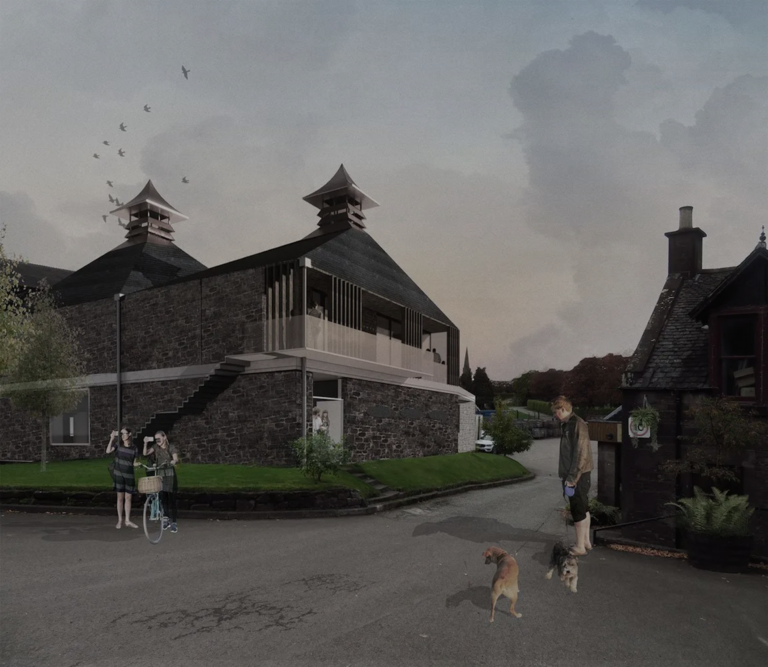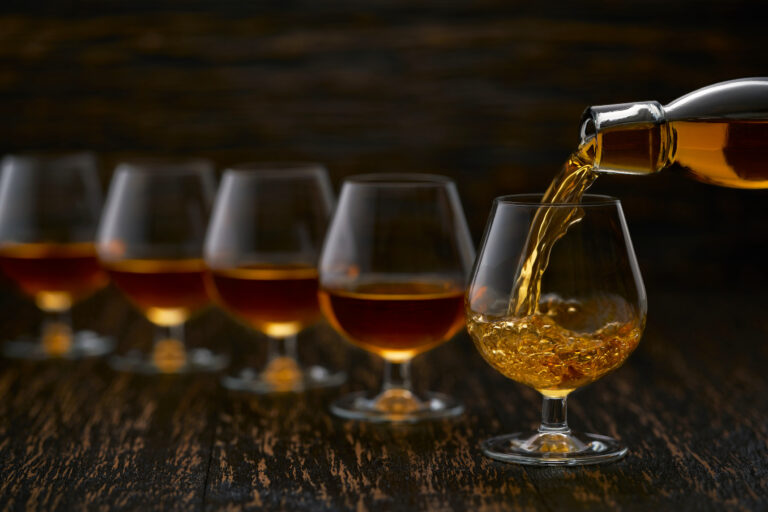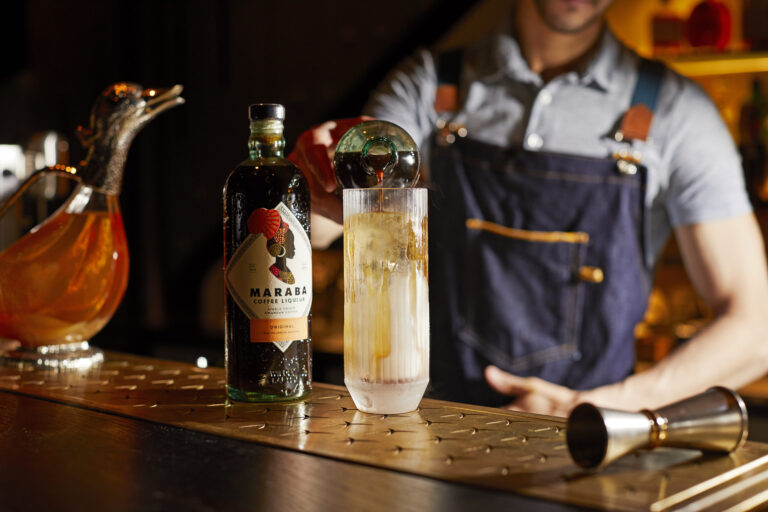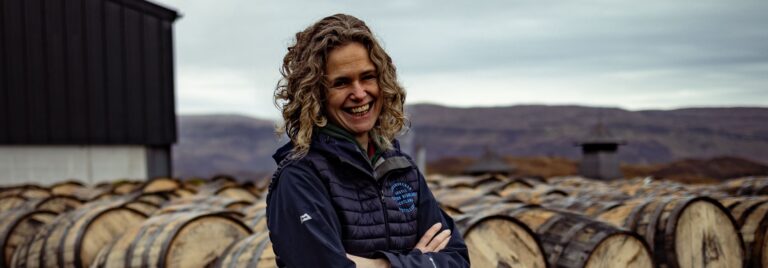Nobody – and we mean nobody – bats an eye that 95 percent of all UK gin distillers start with bought ethanol spirit. But with rum, that’s a completely different story. There are those who buy rum, redistill with spices, and call it their own, very similar to gin production. However, there are those who believe if it says ‘rum’ on the bottle, you need to start with sugar cane molasses. And perhaps no other group is so strong in this belief than Scottish rum distillers.
Dr Kit Carruthers bio reads like this. For 18-years he worked as an environmental geoscientist in Edinburg and completed a doctorate in 2016 in carbon storage and capture. Now? He’s the founder, distiller, filler, seller, and chief bottle washer at Scotland’s Ninefold Distillery.
What happened?
“That’s a good question,” he says, “and one I used to ask myself every day.”
With an impressive CV such as that, to most of us it would seem that Carruthers was holding the Golden Ticket, the world was his oyster, and everyone would be beating a path to his door. To use one more tired but appropriate synonym, only the sky was his limit.
But those in academia and research know better. The further you go up the academic food chain and the more qualified you get, the harder it is to get a job that is even vaguely related to what you studied. For some then, the answer is to chase after grants to do more research. With this, however, the competition is even harder and if you’re not well published in respectable science journals, good luck.
“I wasn’t really sure what my next step was. I’ve never been very good at having a very fixed idea in my head of what I want my life to be like and what my career was going to be. I tend to jump from one thing to another as I have done pretty much all my life,” admits Carruthers. “My options were limited.”



What Kit Carruthers did know about himself was that he didn’t mind pushing himself, putting in long hours, and setting his own schedule. But he did mind greatly when someone else was dictating how this was to be done.
There is, however, more to this than just work independence. When pursuing his PhD, he became ill with Crohn’s disease. Also referred to as inflammatory bowel disease (IBD), there is no cure and living with Crohn’s disease can be difficult at times. Unpredictable flare-ups and regular check-ups with your care team can disrupt work and your social life. Carruthers realised that living with disease would be far easier if he didn’t have a boss and following someone’s else’s time sheet.
“With Crohn’s, I would have to justify as to why I wasn’t at work or why I haven’t done something. That helped to push me down the road to setting up my own businesses,” he says.
His family owned land in the south of Scotland in Dumfries and Galloway, fairly close to Lockerbie. His father started talking about retirement and Kit decided to take on his family’s inheritance and run the estate.
His first thought was to open up a craft brewery, figuring this would be a cool thing to do, despite having no experience other than to drink it. His ties to distilling were just as tenuous.
After rejecting the idea of a brewery, Carruther’s attention turned to gin. But then a property about a half mile from the estate was bought up, with the buyers planning on turning it into a gin distillery.
“I thought gin is such a saturated market, I would struggle as a new brand, and I figured I rather be an early entrant into an emerging market, where I’d be in a stronger position to really capitalise on the growth of it,” he says. “That’s where the idea for rum came from. With whisky, it was something I was never really a big fan of and besides, you need to have really deep pockets to set up a whisky distillery.
“Rum is great because if you’re making it from scratch, it’s the same philosophy as whiskey, but you don’t have to wait for it to age. You can make it, bottle it, and sell it. From a cash point of view, it seemed like a win-win-win.”
While rum can be a breeze to make if you just buy in already made rum and flavour it like many folks are doing, from the beginning Carruthers decided to make it from scratch using sugarcane molasses.
“It never even crossed my mind that I would buy in someone else’s rum, to redistilled or flavour or do something else with it. I didn’t even consider that an option. It was always going to be that I was going to buy the molasses and I was going to ferment and distil it. That was always, always, the way it was going to be.”
Not that he knew how to do this.
In 2017 there were few making rum this way in the UK, but Carruthers was able to visit one and see how things were done. He took a three-day craft distilling course but found it to be all theoretical and not practical. He contacted Heriot Watt University and they put him in contact with some master students who helped him, but for the most part, he learned how to make rum by talking to as many people as possible and trying to absorb as much knowledge as possible.
Although on the estate were some old unused buildings, it wasn’t the plan in the beginning to convert one into a distillery for numerous reasons. The savings by renting an industrial unit – anywhere in Scotland – instead of rebuilding a ruin would be around £200,000. Labour would be easy to find, as would access to other necessary businesses, even shipping rum would be much easier from an industrial area.
“Rurally in Dumfries and Galloway, converting a tumbled down stone building is not the most cash efficient way of setting up a business, but this is mine and it’s in a beautiful place in the country.”

Hindsight 20/20
One mistake that Carruthers made that Distillers see other new producers make as well is that they do not start big. You’re either going to succeed or fail so plan on success. For Carruthers, he opened the distillery in 2019; three years later he’s having to expand.
“Yeah, hindsight is a wonderful thing, right? I should have bought a bigger still, but when you’re putting a significant amount of capital into a project, it can be quite difficult to see where the future is, what is worth spending money on and what isn’t.”
Carruthers had toyed with the idea of buying a cheap Portuguese still but went for a Scottish-built one instead. He bought a 500-litre bespoke copper pot, with a four-plate rectifying column. If he had gone with a 1,000-litre pot instead, it would have nearly doubled the price. At the time, with so much uncertainty regarding the success of his distillery, this was not something he could justify.
Now, however, he sees that would have been the right decision. “I’m looking at basically having to buy a second still and on top of what I’ve already got, a second still is a very significant investment.”
Another assumption he made was that the supply of glass bottles would not change. The original stock he bought in 2018 was just enough to get started. By 2020 he needed new bottles.
“I just assumed that I’d be able to go back to my original bottle manufacturer and get more bottles – I think like most people do. Well, I was wrong.”
At first, he was going to find another off-the-shelf bottle, but then it struck him that if the design became popular, he’d be back once again searching for new bottles when the design sold out. Instead, he decided to bite the bullet and go with a full custom bottle.
“Going the bespoke route when you’re two years into a business is not ideal. It’s the kind of thing that you want to either when you just launch, or you know much further down the line you’re going to be a much bigger company and you’ve got that kind of cash behind you.”
However, it worked out extremely well for him. Freelance designer Ed Bell created an amazing bottle for Ninefold Distillery which was produced by VetroElite. He ordered a quantity that he hopes will last for at least three years (lucky he has plenty of storage space). If he runs out of bottles, no problem, he has the moulds for the bottles to make more.
Sugarcane molasses
Carruthers buys molasses from a broker. He thinks most of it comes from North Africa, but his broker is not upfront about this – describing it as a blend of various sources – which Carruthers doesn’t find ideal. If you are trying to have a 100 percent transparent operation, not knowing exactly where your key ingredient is from gives one a pause.
He mixes the molasses with warm water and yeast in a single 1,500 litre fermentation tank. At the end of four days, he has a wash which is around 9-10% ABV.

Because his pot is only 500 litres, he has to do batches of stripping runs. In the end, it takes about a week to produce a tank of about 100 litres of 90% ABV rum.
“I then cut that down with filtered tap water to whatever ABV that I need to get to, depending on what I’m doing with it. I do 10% ABV steps every day just to just to take it easy on the ABV reduction to try and retain as much of the character and flavour of the rum as I can.”
His Pure Single Rum is at 46% ABV; Dormont Spice is 40% ABV; and Cask Aged Pure Single Rum is 45% ABV.
The aged rum in put into mostly virgin American oak and some ex-bourbon casks of various varieties. Recently he had casks made from trees that he felled on the estate in 2018.
“Weirdly, I do have my chainsaw training but no distilling training. The oak was milled and dried on the estate for four years and then recently I had a cooper use the wood to make standard barrels,” he says. “I know, they’re not the first Scottish oak barrels to be made for spirits, but certainly no one has done rum in them.”
In addition to the oak, he had the cooper make 100 litre barrels out of some storm damaged beech. The cooper never worked with beech before, and no one has aged rum in beech so this should be a bit of an experiment.
Marketing
A problem all distillers have is marketing their brand. This is amplified a million times over for small craft who lack a budget.
Carruthers says that Ninefold is largely marketed through social media, with the push being that except for the sugarcane molasses, all the fermentation, distillation, aging, flavouring (for the spiced rum), bottling, and labelling is done on site.
“It’s a limited, premium product in in the truest sense of the word. I’m involved in every, every part of it so I know its high quality,” he says.
What he finds amusing that at tasting events or when people come by the distillery, they make the assumption that he’s just the rep, “poking” some products on behalf of an employer.
“When I tell them I make the rum, they get a real connection: ‘This is the guy who makes the drink we like’. I think that’s really, really powerful and helps in selling Ninefold Rum,” he says. “In Scotland they’re used to gins and whiskies, but Scottish rum is a new thing to most people. Inevitably people might be a little sceptical about it, they assume rum has to be a Caribbean product. But if you can engage with people and tell them his is how it’s made, this is the process, and things like that, they buy into the product the same way they buy into gins and whiskies.”

2023 and beyond
What worries Carruthers the most right now is the cost of energy. While in the UK gas and electricity is expensive, it seems to be rising daily due to the on-going Ukraine/Russia war, the cold winter, and inflation due in part to the loss of value of the pound. His biggest draw of power is the electric boiler for the still, but the whole operation is power intensive.
“At the moment, my electricity costs are fixed until the end of January 2023, but at that point, they will triple or quadruple in price. That’s about seven or eight percent which will be added onto the cost of production which is quite a big uplift. So, that’s the challenge.
“The logical thing would be to pass on the cost to consumers, but with the economy right now combined with inflation, people will have to be making cutbacks.
“I don’t think anyone really knows whether people are going to have the money to spend on luxuries like premium spirits. There’s an uncertainty as to how much are we actually going to sell and about whether people are going have the money to spend it on Ninefold? “So yeah, the next 12 months, and longer are potentially going to be quite challenging in terms of how much we can actually sell, and how much it’s going to cost to produce,” says Carruthers.









